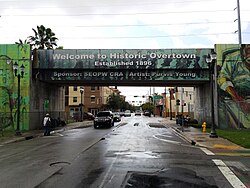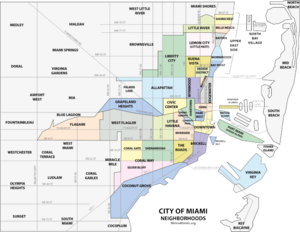Overtown (Miami)
|
Overtown Central Negro District (historic) |
|
|---|---|
| Neighborhood of Miami | |

NW 3rd Avenue
|
|
| Nickname(s): Colored Town (historic name) | |
 Overtown neighborhood within the City of Miami |
|
| Coordinates: 25°47′14.92″N 80°12′2.32″W / 25.7874778°N 80.2006444°WCoordinates: 25°47′14.92″N 80°12′2.32″W / 25.7874778°N 80.2006444°W | |
| Country | United States |
| State | Florida |
| County | Miami-Dade County |
| City | Miami |
| Government | |
| • City of Miami Commissioner | Keon Hardemon |
| • Miami-Dade Commissioners | Audrey Edmonson |
| • House of Representatives | Cynthia Stafford (D) |
| • State Senate | Larcenia Bullard (D) |
| • U.S. House | Frederica Wilson (D) |
| Population (2010) | |
| • Total | 6,736 |
| • Density | 8,820/sq mi (3,410/km2) |
| • Demonym | Towner |
| Time zone | EST (UTC-05) |
| ZIP Code | 33136 |
| Area code(s) | 305, 786 |
Overtown is a neighborhood of Miami, Florida, United States, just northwest of Downtown Miami. Originally called Colored Town during the Jim Crow era of the late 19th through the mid-20th century, the area was once the preeminent and is the historic center for commerce in the black community in Miami and South Florida.
Now roughly bound by North 20th Street to the north, North Fifth Street to the south, the Miami River and Dolphin Expressway (SR 836) to the west, and the Florida East Coast Railway (FEC) and West First Avenue to the east. Local residents often go by the demonym "Towners."
A part of the historic heart of Miami, it was designated as a "colored" neighborhood after the creation and incorporation of Miami in 1896. The incorporation of Miami as a city occurred at the insistence of Standard Oil and FEC railroad tycoon Henry Flagler, whose mostly black American railroad construction workers settled near what became Downtown Miami, just north of Flagler's Royal Palm Hotel on the Miami River. Owing to a substantive black population, 168 of the 362 men who voted for the creation of the city of Miami were counted as "colored," but the separate but equal segregation laws of the Deep South dictated the city designate the portion of the city, in this case, north and west of FEC railroad tracks, as "Colored Town."
...
Wikipedia
